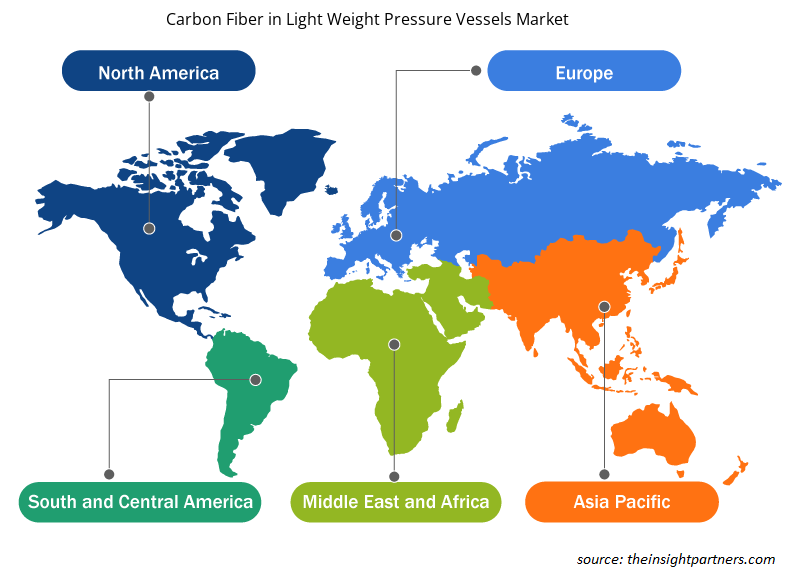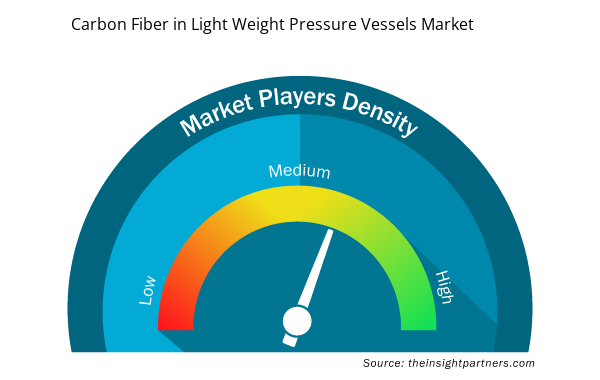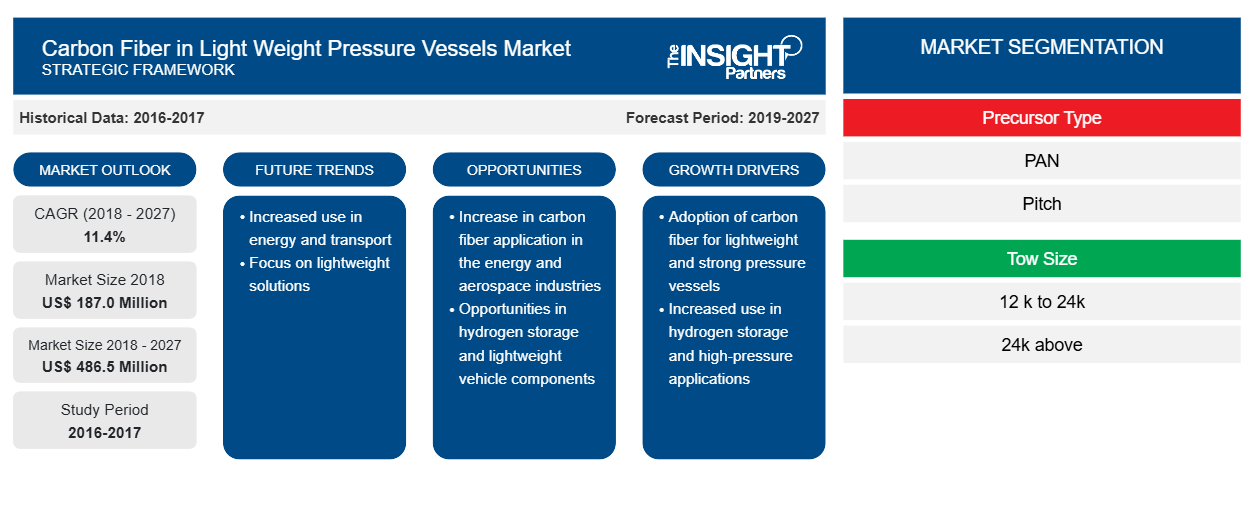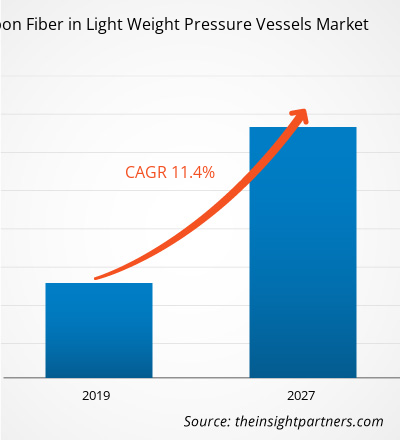El mercado global de fibra de carbono en recipientes a presión livianos representó US$ 187,0 millones en 2018 y se espera que crezca a una CAGR del 11,4% durante el período de pronóstico 2019 - 2027, para representar US$ 486,5 millones para 2027.
La región de Asia Pacífico es la región de más rápido crecimiento para los recipientes a presión basados en fibra de carbono, debido al aumento de la población y las crecientes preocupaciones ambientales de los gobiernos en países como India, China y Japón, junto con el creciente enfoque en vehículos de GNC respetuosos con el medio ambiente y de bajo consumo energético. Además, también se espera que la creciente demanda de la industria automotriz impulse el crecimiento del mercado de recipientes a presión livianos de fibra de carbono en la región.
Perspectivas del mercado
Las crecientes demandas de las aplicaciones automotrices e industriales brindan una oportunidad para el crecimiento del mercado de fibra de carbono en recipientes a presión livianos.
La fibra de carbono ofrece un módulo alto y resistencia específica, alta resistencia a la fatiga, alta rigidez, capacidad de soportar alta presión, coeficiente de expansión térmica más bajo, resistencia a la corrosión y otras propiedades beneficiosas, lo que la hace útil en recipientes a presión para aplicaciones automotrices y otras aplicaciones industriales. Además, se espera que la creciente demanda de materiales livianos, junto con las iniciativas gubernamentales para reducir las emisiones de gases nocivos y aumentar la eficiencia del combustible, impulsen el mercado de la fibra de carbono en recipientes a presión livianos para aplicaciones automotrices.
Personalice este informe según sus necesidades
Obtendrá personalización en cualquier informe, sin cargo, incluidas partes de este informe o análisis a nivel de país, paquete de datos de Excel, así como también grandes ofertas y descuentos para empresas emergentes y universidades.
- Obtenga las principales tendencias clave del mercado de este informe.Esta muestra GRATUITA incluirá análisis de datos, desde tendencias del mercado hasta estimaciones y pronósticos.
La creciente aplicación de recipientes a presión basados en fibra de carbono en vehículos con pilas de combustible creará oportunidades de crecimiento para el mercado global de recipientes a presión livianos basados en fibra de carbono
Se espera que el mercado mundial de fibra de carbono en recipientes a presión livianos experimente una creciente demanda de fibras de carbono en recipientes herméticos para el almacenamiento de gas hidrógeno a alta presión. La fibra de carbono se considera la mejor opción para la producción de recipientes a presión confiables y seguros, ya que tiene la capacidad de soportar la alta presión del hidrógeno, por lo que los fabricantes de automóviles globales están cada vez más involucrados en el desarrollo de vehículos de celdas de combustible, así como los respectivos gobiernos nacionales también están brindando apoyo para la construcción de infraestructura para la producción de vehículos de celdas de combustible.
Perspectivas de los precursores
Sobre la base de los precursores, el mercado mundial de fibra de carbono en recipientes a presión de peso ligero se ha segmentado en poliacrilonitrilo (PAN) y brea. El segmento de poliacrilonitrilo (PAN) lideró el mercado mundial de fibra de carbono en un recipiente a presión ligero. El poliacrilonitrilo (PAN) es una fibra de carbono que contiene aproximadamente el 68% de carbono y es uno de los precursores más utilizados para las fibras de carbono. El PAN se polimeriza a partir del acrilonitrilo (AN) mediante los inhibidores de uso común, como los compuestos azo y los peróxidos, a través del proceso de polimerización. La creciente demanda de fibra de carbono en los recipientes a presión ligeros ha provocado un aumento de la fabricación y producción de PAN, ya que es uno de los precursores más utilizados.
Información sobre el tamaño del remolque
El mercado mundial de fibra de carbono en recipientes a presión de peso ligero por tamaño de cable se ha segmentado en 12k a 24k y más de 24K. El segmento de 12k a 24k representó la mayor participación en el mercado mundial de fibra de carbono en recipientes a presión de peso ligero. La naturaleza pesada y rígida de las fibras de carbono de tamaño de cable de 12k a 24k demuestra ser beneficiosa en las aplicaciones de equipos militares y científicos, que son un factor importante que contribuye al crecimiento y la expansión de la fibra de carbono de tamaño de cable de 12K a 24K en todo el mundo. Algunos de los principales actores clave que fabrican la fibra de carbono de 12K a 24K son Toray Composite Materials America, Inc., Teijin Limited, SGL group, entre muchos otros.
Perspectivas regionales del mercado de fibra de carbono en recipientes a presión livianos
Los analistas de Insight Partners explicaron en detalle las tendencias y los factores regionales que influyen en el mercado de fibra de carbono en recipientes a presión livianos durante el período de pronóstico. Esta sección también analiza los segmentos y la geografía del mercado de fibra de carbono en recipientes a presión livianos en América del Norte, Europa, Asia Pacífico, Medio Oriente y África, y América del Sur y Central.

- Obtenga datos regionales específicos para el mercado de fibra de carbono en recipientes a presión livianos
Alcance del informe de mercado sobre la fibra de carbono en recipientes a presión ligeros
| Atributo del informe | Detalles |
|---|---|
| Tamaño del mercado en 2018 | US$ 187,0 millones |
| Tamaño del mercado en 2027 | US$ 486,5 millones |
| Tasa de crecimiento anual compuesta (CAGR) global (2018-2027) | 11,4% |
| Datos históricos | 2016-2017 |
| Período de pronóstico | 2019-2027 |
| Segmentos cubiertos | Por tipo de precursor
|
| Regiones y países cubiertos | América del norte
|
| Líderes del mercado y perfiles de empresas clave |
|
Densidad de actores del mercado: comprensión de su impacto en la dinámica empresarial
El mercado de fibra de carbono en recipientes a presión livianos está creciendo rápidamente, impulsado por la creciente demanda de los usuarios finales debido a factores como la evolución de las preferencias de los consumidores, los avances tecnológicos y una mayor conciencia de los beneficios del producto. A medida que aumenta la demanda, las empresas amplían sus ofertas, innovan para satisfacer las necesidades de los consumidores y aprovechan las tendencias emergentes, lo que impulsa aún más el crecimiento del mercado.
La densidad de actores del mercado se refiere a la distribución de las empresas o firmas que operan dentro de un mercado o industria en particular. Indica cuántos competidores (actores del mercado) están presentes en un espacio de mercado determinado en relación con su tamaño o valor total de mercado.
Las principales empresas que operan en el mercado de fibra de carbono en recipientes a presión livianos son:
- CORPORACIÓN HYOSUNG
- Solvay
- Corporación Formosa Plastics
- Industrias Toray, Inc.
- Teijin limitada
Descargo de responsabilidad : Las empresas enumeradas anteriormente no están clasificadas en ningún orden particular.

- Obtenga una descripción general de los principales actores clave del mercado de fibra de carbono en recipientes a presión livianos
Las fusiones y adquisiciones, los escenarios de inversión, el desarrollo de nuevos productos y otros se consideraron las estrategias más adoptadas en el mercado global de fibra de carbono en recipientes a presión livianos. A continuación, se enumeran algunos de los desarrollos recientes en el mercado global de fibra de carbono en recipientes a presión livianos:
- 2019: Teijin Limited acordó adquirir Renegade Materials Corporation (Renegade) a través de la cual Teijin busca fortalecer sus negocios de fibra de carbono y materiales intermedios para mantener su posición como proveedor líder de soluciones para aplicaciones aeroespaciales.
- 2018: Toray Industries Inc. celebró un acuerdo con Koninklijke Ten Cate BV para comprar todas las acciones de su subsidiaria TenCate Advanced Composites Holding BV. Se esperaba que esta adquisición produjera sinergias sustanciales al combinar la línea de productos de esta última con la gama de tecnologías de fibra de carbono junto con polímeros.
- 2017: Hexcel lanzó MAXIM, un nuevo proyecto respaldado por el gobierno con £7,4 millones en investigación y desarrollo de tejidos de fibra de carbono y amplió sus instalaciones de fabricación en Leicester.
SEGMENTACIÓN DEL MERCADO GLOBAL DE FIBRA DE CARBONO EN RECIPIENTES A PRESIÓN LIGEROS
Por precursores
- Poliacrilonitrilo (PAN)
- Paso
Por tamaño de remolque
- 12k a 24k
- Más de 24k
Por geografía
América del norte
- A NOSOTROS
- Canadá
- México
Europa
- Alemania
- Francia
- Italia
- Reino Unido
- Rusia
- Resto de Europa
Asia Pacífico
- Australia
- Porcelana
- India
- Japón
- Corea del Sur
- Resto de Asia Pacífico
Resto del mundo
- Brasil
- Argentina
- Resto de Sudamérica (SAM)
Perfiles de empresas
- CORPORACIÓN HYOSUNG
- Solvay
- Corporación Formosa Plastics
- Industrias Toray, Inc.
- Teijin limitada
- SGL Carbon
- Corporación química Mitsubishi
- Corporación Kureha
- Corporación Hexcel
- Dowaksa
- Análisis histórico (2 años), año base, pronóstico (7 años) con CAGR
- Análisis PEST y FODA
- Tamaño del mercado Valor/volumen: global, regional, nacional
- Industria y panorama competitivo
- Conjunto de datos de Excel



Report Coverage
Revenue forecast, Company Analysis, Industry landscape, Growth factors, and Trends

Segment Covered
This text is related
to segments covered.

Regional Scope
North America, Europe, Asia Pacific, Middle East & Africa, South & Central America

Country Scope
This text is related
to country scope.
Preguntas frecuentes
The heavy and stiff nature of 12k to 24k tow size carbon fibers prove to be beneficial in the military and scientific equipment.
The Polyacrylonitrile (PAN) is commonly used precursor for carbon fiber in a lightweight pressure vessels industry. It contains approximately 68% of carbon and is one of the most widely used precursors for carbon fibers.
APAC region is the fastest-growing region for carbon fiber-based pressure vessels, owing to increasing population and growing environmental concerns governments in countries such as India, China, and Japan coupled with the rising focus on energy-efficient and environmental friendly CNG vehicles.
Trends and growth analysis reports related to Chemicals and Materials : READ MORE..
The List of Companies
- HYOSUNG CORPORATION
- Solvay
- Formosa Plastics Corporation
- Toray Industries, Inc
- Teijin Limited
- SGL Carbon
- Mitsubishi Chemical Corporation
- Kureha Corporation
- Hexcel Corporation
- Dowaksa
The Insight Partners performs research in 4 major stages: Data Collection & Secondary Research, Primary Research, Data Analysis and Data Triangulation & Final Review.
- Data Collection and Secondary Research:
As a market research and consulting firm operating from a decade, we have published and advised several client across the globe. First step for any study will start with an assessment of currently available data and insights from existing reports. Further, historical and current market information is collected from Investor Presentations, Annual Reports, SEC Filings, etc., and other information related to company’s performance and market positioning are gathered from Paid Databases (Factiva, Hoovers, and Reuters) and various other publications available in public domain.
Several associations trade associates, technical forums, institutes, societies and organization are accessed to gain technical as well as market related insights through their publications such as research papers, blogs and press releases related to the studies are referred to get cues about the market. Further, white papers, journals, magazines, and other news articles published in last 3 years are scrutinized and analyzed to understand the current market trends.
- Primary Research:
The primarily interview analysis comprise of data obtained from industry participants interview and answers to survey questions gathered by in-house primary team.
For primary research, interviews are conducted with industry experts/CEOs/Marketing Managers/VPs/Subject Matter Experts from both demand and supply side to get a 360-degree view of the market. The primary team conducts several interviews based on the complexity of the markets to understand the various market trends and dynamics which makes research more credible and precise.
A typical research interview fulfils the following functions:
- Provides first-hand information on the market size, market trends, growth trends, competitive landscape, and outlook
- Validates and strengthens in-house secondary research findings
- Develops the analysis team’s expertise and market understanding
Primary research involves email interactions and telephone interviews for each market, category, segment, and sub-segment across geographies. The participants who typically take part in such a process include, but are not limited to:
- Industry participants: VPs, business development managers, market intelligence managers and national sales managers
- Outside experts: Valuation experts, research analysts and key opinion leaders specializing in the electronics and semiconductor industry.
Below is the breakup of our primary respondents by company, designation, and region:

Once we receive the confirmation from primary research sources or primary respondents, we finalize the base year market estimation and forecast the data as per the macroeconomic and microeconomic factors assessed during data collection.
- Data Analysis:
Once data is validated through both secondary as well as primary respondents, we finalize the market estimations by hypothesis formulation and factor analysis at regional and country level.
- Macro-Economic Factor Analysis:
We analyse macroeconomic indicators such the gross domestic product (GDP), increase in the demand for goods and services across industries, technological advancement, regional economic growth, governmental policies, the influence of COVID-19, PEST analysis, and other aspects. This analysis aids in setting benchmarks for various nations/regions and approximating market splits. Additionally, the general trend of the aforementioned components aid in determining the market's development possibilities.
- Country Level Data:
Various factors that are especially aligned to the country are taken into account to determine the market size for a certain area and country, including the presence of vendors, such as headquarters and offices, the country's GDP, demand patterns, and industry growth. To comprehend the market dynamics for the nation, a number of growth variables, inhibitors, application areas, and current market trends are researched. The aforementioned elements aid in determining the country's overall market's growth potential.
- Company Profile:
The “Table of Contents” is formulated by listing and analyzing more than 25 - 30 companies operating in the market ecosystem across geographies. However, we profile only 10 companies as a standard practice in our syndicate reports. These 10 companies comprise leading, emerging, and regional players. Nonetheless, our analysis is not restricted to the 10 listed companies, we also analyze other companies present in the market to develop a holistic view and understand the prevailing trends. The “Company Profiles” section in the report covers key facts, business description, products & services, financial information, SWOT analysis, and key developments. The financial information presented is extracted from the annual reports and official documents of the publicly listed companies. Upon collecting the information for the sections of respective companies, we verify them via various primary sources and then compile the data in respective company profiles. The company level information helps us in deriving the base number as well as in forecasting the market size.
- Developing Base Number:
Aggregation of sales statistics (2020-2022) and macro-economic factor, and other secondary and primary research insights are utilized to arrive at base number and related market shares for 2022. The data gaps are identified in this step and relevant market data is analyzed, collected from paid primary interviews or databases. On finalizing the base year market size, forecasts are developed on the basis of macro-economic, industry and market growth factors and company level analysis.
- Data Triangulation and Final Review:
The market findings and base year market size calculations are validated from supply as well as demand side. Demand side validations are based on macro-economic factor analysis and benchmarks for respective regions and countries. In case of supply side validations, revenues of major companies are estimated (in case not available) based on industry benchmark, approximate number of employees, product portfolio, and primary interviews revenues are gathered. Further revenue from target product/service segment is assessed to avoid overshooting of market statistics. In case of heavy deviations between supply and demand side values, all thes steps are repeated to achieve synchronization.
We follow an iterative model, wherein we share our research findings with Subject Matter Experts (SME’s) and Key Opinion Leaders (KOLs) until consensus view of the market is not formulated – this model negates any drastic deviation in the opinions of experts. Only validated and universally acceptable research findings are quoted in our reports.
We have important check points that we use to validate our research findings – which we call – data triangulation, where we validate the information, we generate from secondary sources with primary interviews and then we re-validate with our internal data bases and Subject matter experts. This comprehensive model enables us to deliver high quality, reliable data in shortest possible time.


 Obtenga una muestra gratuita de este informe
Obtenga una muestra gratuita de este informe